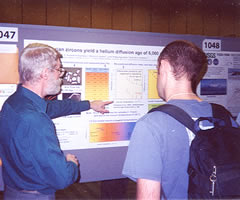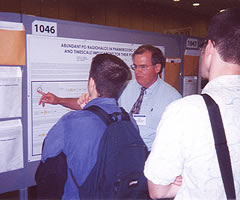RATE Posters Well Received at AGU Conference
Three RATE scientists presented posters at the 2003 American Geophysical Union Fall Conference in San Francisco in early December. John Baumgardner, Russell Humphreys, and Larry Vardiman each offered exciting results coming from research on Radioisotopes and the Age of the Earth for the first time to a general science conference. The posters were well received by the organizers and attendees at the conference.
About 10,000 scientists from all fields of geophysics meet annually at the Moscone Center in San Francisco to make presentations on their latest research. This year's conference included a session on the Centennial Celebration of Radioisotopic Geochronology: Dates, Rates, and New Debates. Abstracts at the conference may be reviewed at their website under Fall 2003 conference. This seemed like an ideal opportunity for RATE to report its latest results in a public forum.

Dr. John Baumgardner from Los Alamos National Laboratory and an active member of the RATE group reported on The Enigma of the Ubiquity of 14C in Organic Samples Older than 100 ka ( V32C-1045). He discussed his findings that various geological samples which are thought to be millions of years old, including diamonds, contain measurable amounts of Carbon-14. Samples this old should Dr. John Baumgardnerhave no Carbon-14 because it would have all decayed by now. Residual Carbon-14 found above the background level indicates that these samples thought to be millions of years old can be at most thousands of years old. The presence of Carbon-14 in diamond was of particular interest because diamonds eliminate the likelihood of contamination.

The three papers were controversial but were accepted for poster presentations by the AGU organizing committee and were well received by those who interacted with the authors. The RATE scientists were greatly encouraged by the good reception they received. Some of the scientists who visited and talked with them were from radioisotope laboratories at the University of California at Berkeley, Lawrence Livermore, Yale, the Massachusetts Institute of Technology, the University of Michigan, etc. The visiting scientists did not necessarily agree with the conclusions but the authors received no major negative comments. Some visitors actually offered suggestions to assist in future research. We hope these researchers will spread the word that Creationist scientists are conducting quality work and have solid evidence for a completely different paradigm about the age of the earth.
Posters from conference:
- AGU Poster by Dr. D. Russell Humphreys-Precambrian Zircons Yield a Helium Diffusion Age of 6,000 years (December, 2003).
- AGU Poster by Dr. John R. Baumgardner-The Enigma of the Ubiquity of 14C in Organic Samples Older than 100 ka (December, 2003).
- AGU Poster by Dr. Andrew Snelling-Abundant Po Radiohalos in Phanerozoic Granites and Timescale Implications for their Formation (December, 2003).



